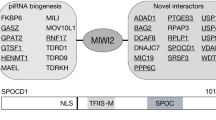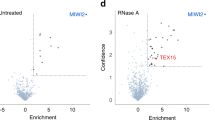Abstract
Repetitive-element-derived Piwi-interacting RNAs (piRNAs)1,2 act together with Piwi proteins Mili (also known as Piwil2) and Miwi2 (also known as Piwil4) in a genome defence mechanism that initiates transposon silencing via DNA methylation in the mouse male embryonic germ line. This silencing depends on the participation of the Piwi proteins in a slicer-dependent piRNA amplification pathway and is essential for male fertility3,4. A third Piwi family member, Miwi (also known as Piwil1), is expressed in specific postnatal germ cells and associates with a unique set of piRNAs of unknown function5,6,7. Here we show that Miwi is a small RNA-guided RNase (slicer) that requires extensive complementarity for target cleavage in vitro. Disruption of its catalytic activity in mice by a single point mutation causes male infertility, and mutant germ cells show increased accumulation of LINE1 retrotransposon transcripts. We provide evidence for Miwi slicer activity directly cleaving transposon messenger RNAs, offering an explanation for the continued maintenance of repeat-derived piRNAs long after transposon silencing is established in germline stem cells. Furthermore, our study supports a slicer-dependent silencing mechanism that functions without piRNA amplification. Thus, Piwi proteins seem to act in a two-pronged mammalian transposon silencing strategy: one promotes transcriptional repression in the embryo, the other reinforces silencing at the post-transcriptional level after birth.
This is a preview of subscription content, access via your institution
Access options
Subscribe to this journal
Receive 51 print issues and online access
$199.00 per year
only $3.90 per issue
Buy this article
- Purchase on SpringerLink
- Instant access to full article PDF
Prices may be subject to local taxes which are calculated during checkout




Similar content being viewed by others
References
Siomi, M. C., Sato, K., Pezic, D. & Aravin, A. A. PIWI-interacting small RNAs: the vanguard of genome defence. Nature Rev. Mol. Cell Biol. 12, 246–258 (2011)
Ghildiyal, M. & Zamore, P. D. Small silencing RNAs: an expanding universe. Nature Rev. Genet. 10, 94–108 (2009)
Aravin, A. A. et al. A piRNA pathway primed by individual transposons is linked to de novo DNA methylation in mice. Mol. Cell 31, 785–799 (2008)
Kuramochi-Miyagawa, S. et al. DNA methylation of retrotransposon genes is regulated by Piwi family members MILI and MIWI2 in murine fetal testes. Genes Dev. 22, 908–917 (2008)
Deng, W. & Lin, H. miwi, a murine homolog of piwi, encodes a cytoplasmic protein essential for spermatogenesis. Dev. Cell 2, 819–830 (2002)
Girard, A., Sachidanandam, R., Hannon, G. J. & Carmell, M. A. A germline-specific class of small RNAs binds mammalian Piwi proteins. Nature 442, 199–202 (2006)
Grivna, S. T., Beyret, E., Wang, Z. & Lin, H. A novel class of small RNAs in mouse spermatogenic cells. Genes Dev. 20, 1709–1714 (2006)
Vagin, V. V. et al. Proteomic analysis of murine Piwi proteins reveals a role for arginine methylation in specifying interaction with Tudor family members. Genes Dev. 23, 1749–1762 (2009)
Vasileva, A., Tiedau, D., Firooznia, A., Muller-Reichert, T. & Jessberger, R. Tdrd6 is required for spermiogenesis, chromatoid body architecture, and regulation of miRNA expression. Curr. Biol. 19, 630–639 (2009)
Lau, N. C. et al. Characterization of the piRNA complex from rat testes. Science 313, 363–367 (2006)
Saito, K. et al. Specific association of Piwi with rasiRNAs derived from retrotransposon and heterochromatic regions in the Drosophila genome. Genes Dev. 20, 2214–2222 (2006)
Meister, G. & Tuschl, T. Mechanisms of gene silencing by double-stranded RNA. Nature 431, 343–349 (2004)
Rivas, F. V. et al. Purified Argonaute2 and an siRNA form recombinant human RISC. Nature Struct. Mol. Biol. 12, 340–349 (2005)
Wang, Y. et al. Nucleation, propagation and cleavage of target RNAs in Ago silencing complexes. Nature 461, 754–761 (2009)
Martinez, J. & Tuschl, T. RISC is a 5′ phosphomonoester-producing RNA endonuclease. Genes Dev. 18, 975–980 (2004)
Schwarz, D. S., Tomari, Y. & Zamore, P. D. The RNA-induced silencing complex is a Mg2+-dependent endonuclease. Curr. Biol. 14, 787–791 (2004)
Cifuentes, D. et al. A novel miRNA processing pathway independent of Dicer requires Argonaute2 catalytic activity. Science 328, 1694–1698 (2010)
Cheloufi, S., Dos Santos, C. O., Chong, M. M. & Hannon, G. J. A dicer-independent miRNA biogenesis pathway that requires Ago catalysis. Nature 465, 584–589 (2010)
Caron, C., Govin, J., Rousseaux, S. & Khochbin, S. How to pack the genome for a safe trip. Prog. Mol. Subcell. Biol. 38, 65–89 (2005)
Lee, K., Haugen, H. S., Clegg, C. H. & Braun, R. E. Premature translation of protamine 1 mRNA causes precocious nuclear condensation and arrests spermatid differentiation in mice. Proc. Natl Acad. Sci. USA 92, 12451–12455 (1995)
Kotaja, N. et al. The chromatoid body of male germ cells: similarity with processing bodies and presence of Dicer and microRNA pathway components. Proc. Natl Acad. Sci. USA 103, 2647–2652 (2006)
Lau, N. C. et al. Abundant primary piRNAs, endo-siRNAs, and microRNAs in a Drosophila ovary cell line. Genome Res. 19, 1776–1785 (2009)
Branciforte, D. & Martin, S. L. Developmental and cell type specificity of LINE-1 expression in mouse testis: implications for transposition. Mol. Cell. Biol. 14, 2584–2592 (1994)
Ahmed, E. A. et al. Differences in DNA double strand breaks repair in male germ cell types: lessons learned from a differential expression of Mdc1 and 53BP1. DNA Repair (Amst.) 6, 1243–1254 (2007)
Grivna, S. T., Pyhtila, B. & Lin, H. MIWI associates with translational machinery and PIWI-interacting RNAs (piRNAs) in regulating spermatogenesis. Proc. Natl Acad. Sci. USA 103, 13415–13420 (2006)
Aravin, A. A., Sachidanandam, R., Girard, A., Fejes-Toth, K. & Hannon, G. J. Developmentally regulated piRNA clusters implicate MILI in transposon control. Science 316, 744–747 (2007)
Berninger, P., Jaskiewicz, L., Khorshid, M. & Zavolan, M. Conserved generation of short products at piRNA loci. BMC Genomics 12, 46 (2011)
Reuter, M. et al. Loss of the Mili-interacting Tudor domain-containing protein-1 activates transposons and alters the Mili-associated small RNA profile. Nature Struct. Mol. Biol. 16, 639–646 (2009)
Chuma, S. et al. Tdrd1/Mtr-1, a tudor-related gene, is essential for male germ-cell differentiation and nuage/germinal granule formation in mice. Proc. Natl Acad. Sci. USA 103, 15894–15899 (2006)
Tanaka, T. et al. Tudor domain containing 7 (Tdrd7) is essential for dynamic ribonucleoprotein (RNP) remodeling of chromatoid bodies during spermatogenesis. Proc. Natl Acad. Sci. USA 108, 10579–10584 (2011)
Brahms, H. et al. The C-terminal RG dipeptide repeats of the spliceosomal Sm proteins D1 and D3 contain symmetrical dimethylarginines, which form a major B-cell epitope for anti-Sm autoantibodies. J. Biol. Chem. 275, 17122–17129 (2000)
Heidaran, M. A., Showman, R. M. & Kistler, W. S. A cytochemical study of the transcriptional and translational regulation of nuclear transition protein 1 (TP1), a major chromosomal protein of mammalian spermatids. J. Cell Biol. 106, 1427–1433 (1988)
Stanker, L. H., Wyrobek, A. & Balhorn, R. Monoclonal antibodies to human protamines. Hybridoma 6, 293–303 (1987)
Kotaja, N., Lin, H., Parvinen, M. & Sassone-Corsi, P. Interplay of PIWI/Argonaute protein MIWI and kinesin KIF17b in chromatoid bodies of male germ cells. J. Cell Sci. 119, 2819–2825 (2006)
Kirino, Y. & Mourelatos, Z. Mouse Piwi-interacting RNAs are 2′-O-methylated at their 3′ termini. Nature Struct. Mol. Biol. 14, 347–348 (2007)
Qi, Y. et al. Distinct catalytic and non-catalytic roles of ARGONAUTE4 in RNA-directed DNA methylation. Nature 443, 1008–1012 (2006)
Kontgen, F. & Stewart, C. L. Simple screening procedure to detect gene targeting events in embryonic stem cells. Methods Enzymol. 225, 878–890 (1993)
Farley, F. W., Soriano, P., Steffen, L. S. & Dymecki, S. M. Widespread recombinase expression using FLPeR (flipper) mice. Genesis 28, 106–110 (2000)
Schwenk, F., Baron, U. & Rajewsky, K. A cre-transgenic mouse strain for the ubiquitous deletion of loxP-flanked gene segments including deletion in germ cells. Nucleic Acids Res. 23, 5080–5081 (1995)
Wen, J. & Brogna, S. Nonsense-mediated mRNA decay. Biochem. Soc. Trans. 36, 514–516 (2008)
Shoji, M. et al. The TDRD9-MIWI2 complex is essential for piRNA-mediated retrotransposon silencing in the mouse male germline. Dev. Cell 17, 775–787 (2009)
Karginov, F. V. et al. Diverse endonucleolytic cleavage sites in the mammalian transcriptome depend upon microRNAs, Drosha, and additional nucleases. Mol. Cell 38, 781–788 (2011)
Pivot-Pajot, C. et al. Acetylation-dependent chromatin reorganization by BRDT, a testis-specific bromodomain-containing protein. Mol. Cell. Biol. 23, 5354–5365 (2003)
Olson, A. J., Brennecke, J., Aravin, A. A., Hannon, G. J. & Sachidanandam, R. Analysis of large-scale sequencing of small RNAs. Pac. Symp. Biocomput. 126–136 (2008)
Gentleman, R. C. et al. Bioconductor: open software development for computational biology and bioinformatics. Genome Biol. 5, R80 (2004)
Bengtsson, H., Wirapati, P. & Speed, T. P. A single-array preprocessing method for estimating full-resolution raw copy numbers from all Affymetrix genotyping arrays including GenomeWideSNP 5 & 6. Bioinformatics 25, 2149–2156 (2009)
Smyth, G. K. Linear models and empirical Bayes methods for assessing differential expression in microarray experiments. Stat. Appl. Genet. Mol. Biol. 3, article 3. (2004)
Acknowledgements
We thank S. Cusack for initial support for the project and discussions. We thank D. O’Carroll and S. Khochbin for help with mouse experiments; J. Xiol and N. Nakatsuji for helpful discussions; D. O'Carroll, S. Martin, S. Kistler and R. Balhorn for antibodies. We thank the Mouse Biology Unit, European Molecular Biology Laboratory (EMBL) Monterotondo and EMBL facilities (Gene, Proteomics, Protein Expression and Purification). This work was supported by a Deutsche Forschungsgemeinschaft (DFG) postdoctoral fellowship to M.R. and grants to R.S.P. from Agence National de la Recherche (ANR) (piRmachines) and the European Union (European Research Council, ERC Starting Grant, pisilence). The R.S.P. laboratory is supported by the EMBL.
Author information
Authors and Affiliations
Contributions
M.R. performed all biochemical and deep sequencing experiments. S.C., M.R. and M.H. performed imaging. C.F. and C.A. performed electron microscopy analysis. P.B., R.S., R.S.P. and H.S performed bioinformatics analysis. R.S.P., M.R., S.C. and R.S. prepared the manuscript. M.R. and R.S.P. designed research.
Corresponding author
Ethics declarations
Competing interests
The authors declare no competing financial interests.
Supplementary information
Supplementary Information
The file contains Supplementary Figures 1-14 with legends and Supplementary Tables 1-5. (PDF 2408 kb)
Rights and permissions
About this article
Cite this article
Reuter, M., Berninger, P., Chuma, S. et al. Miwi catalysis is required for piRNA amplification-independent LINE1 transposon silencing. Nature 480, 264–267 (2011). https://doi.org/10.1038/nature10672
Received:
Accepted:
Published:
Issue Date:
DOI: https://doi.org/10.1038/nature10672
This article is cited by
-
AGO2 silences mobile transposons in the nucleus of quiescent cells
Nature Structural & Molecular Biology (2023)
-
An update on the role and potential mechanisms of clock genes regulating spermatogenesis: A systematic review of human and animal experimental studies
Reviews in Endocrine and Metabolic Disorders (2023)
-
From parasites to partners: exploring the intricacies of host-transposon dynamics and coevolution
Functional & Integrative Genomics (2023)
-
Control of LINE-1 Expression Maintains Genome Integrity in Germline and Early Embryo Development
Reproductive Sciences (2022)
-
Building RNA-protein germ granules: insights from the multifaceted functions of DEAD-box helicase Vasa/Ddx4 in germline development
Cellular and Molecular Life Sciences (2022)



